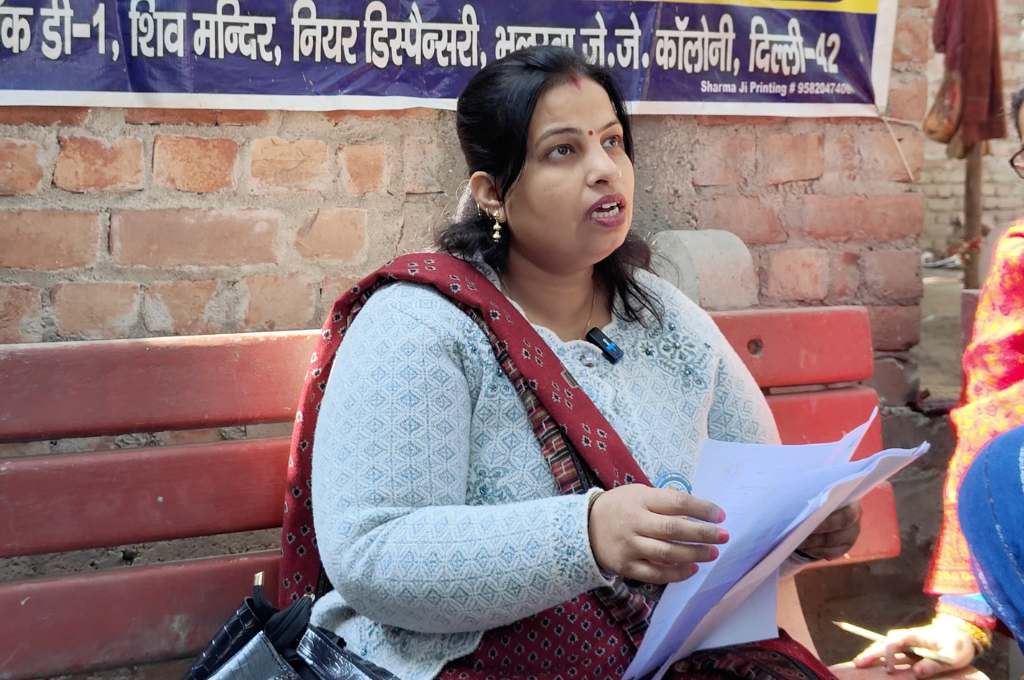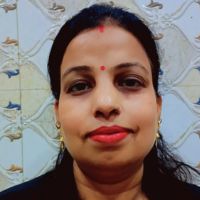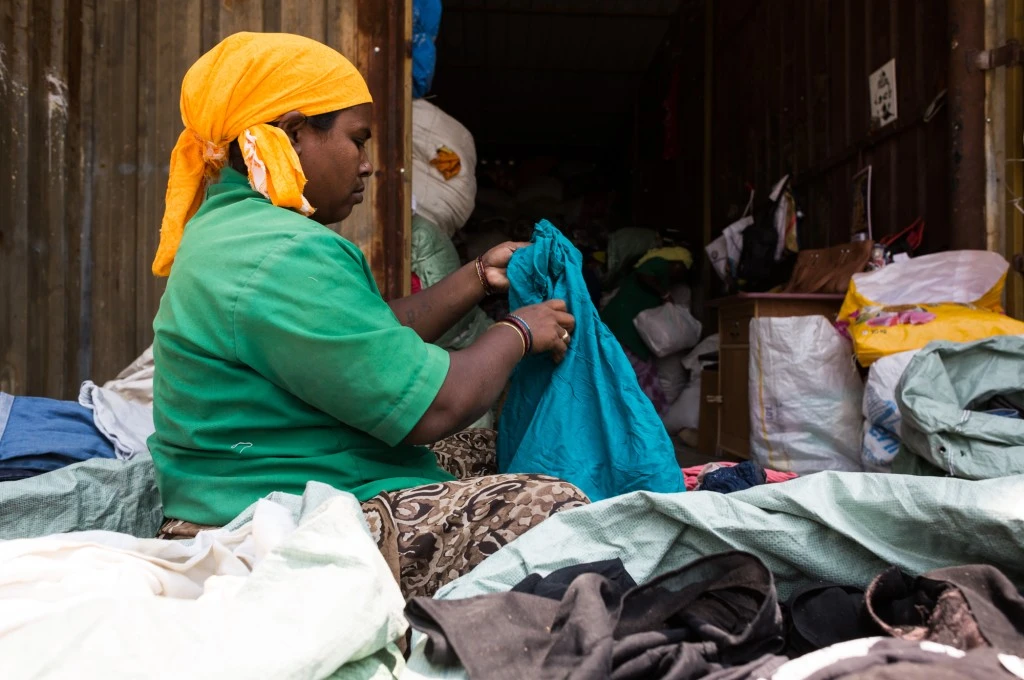Watch this video about a day in the life of Rama, a fieldworker from Delhi, as she helps waste pickers in Bhalswa transition from chulhas to LPG cylinders. Rama, who has been working on the ground for the last 15 years, starts her morning juggling work calls and household chores, and ends her day with Chinese food and Kishore Kumar songs. In the video, Rama shares the challenges she faced both professionally and personally due to the nature of her work. She expresses her dream to build a shelter for women experiencing domestic abuse, and eventually pursuing a career in politics by running for MLA.
My name is Rama and I live in Jahangirpuri with my husband and two sons. For approximately 15 years I have worked on the ground with communities, first as an anganwadi helper and then as an ASHA worker. Currently, I work as a change agent with Asar as part of the Cleaner Air and Better Health (CABH) project supported by the United States Agency for International Development (USAID), and help people in Bhalswa switch to clean cooking fuel. Bhalswa is a neighbourhood located in Northwest Delhi; it is surrounded by a landfill and is predominantly inhabited by waste pickers. Most households in Bhalswa use chulhas (mud stoves) for cooking, which can cause dangerous levels of household air pollution and lead to dire ramifications on the health of the women who do the cooking. LPG gas cylinders, on the other hand, provide a cleaner alternative. They not only help combat air pollution, but are also easier to use and save the time that would otherwise be spent on collecting firewood for chulhas.
I’ve been working with women and men in Bhalswa to raise awareness about the harms of an open fire and cooking with fuels such as wood or coal. However, people are still reluctant to make this switch for several reasons, the primary one being the high costs. Launched in 2016, the Pradhan Mantrir Ujjwala Yojana (PMUY) heavily subsidises the cost of the cylinder to incentivise the transition to cleaner cooking methods. However, many in Bhalswa still lack the correct documentation—including Aadhaar card and labour card—required to avail of the scheme.

As a result, my work has evolved to not only advocate for the benefits of clean cooking but also to create awareness about the PMUY scheme and assisting community members with the documentation necessary for accessing its benefits.
6.00 AM: I usually wake up to the sound of my phone ringing incessantly. It’s almost always someone from Bhalswa calling to ask when I’m coming to their neighbourhood or to enquire about the status of their PMUY form. Today is no different. Amid the chaos of the phone calls. My husband and I prepare breakfast for the family. We also fix our children’s school lunches. My older son is in grade 12 and my younger one is in grade 8. I have a dog, Timsi, who was a birthday gift from a relative. She also needs to be fed and taken for a walk in the morning. My husband, who is an auto driver, tends to her before heading out to work.
The entire family contributes to these chores. I believe that without all their help, it would’ve been very challenging for me to continue working in the field every day. I still remember, when I first started working in the field as an anganwadi helper back in 2011, my younger son was just one year old. My relatives would repeatedly ask me to leave the anganwadi work and take care of my son. My brother even went to the extent of promising me INR 3,000 every month in lieu of a salary. However, I continued working and would take my child to the field with me every day. I’ve always wanted to help people and I felt that was the only way I could contribute.
I usually make myself aloo parathas in the morning as they keep me full until I come back from work in the evening, especially since I can’t eat on the field. Once I’ve had my breakfast, I go over my schedule, which I always prepare the night before. On most days, my work is a combination of spreading door-to-door awareness, conducting public awareness sessions, and helping people fill out forms for PMUY.
Since I work with waste pickers, who start working early in the morning and return to their homes at around noon, I have to structure my schedule around their availability. Today, I have a public awareness session scheduled, after which I will help some of the women in the community fill out forms for PMUY. After making adjustments to my to-do list, I get ready to leave the house to make my way to Bhalswa.
10.00 AM: The bus stop is a 10-minute walk from my house. I wait here for 15 minutes or so for a bus that can drop me at the end of the road. There are days when I can walk the distance, but it’s very hot today and I don’t want to tire myself out so early. I finally board a bus after waiting for 15 minutes at the stop. Once I get off at my stop, I have to wait for a couple of minutes to take a shared e-rickshaw to my final destination. I have to wait a couple of minutes here while the rickshaw driver gathers other passengers travelling in the same direction. Eventually, I arrive at Bhalswa close to 11 am.

Bhalswa is a vast neighbourhood, with localities divided on the basis of religious and regional identities. For instance, some areas have only people from West Bengal, while others have only Muslim families. The various groups living in Bhalswa speak different languages and have distinct cultures, which can be complicated to navigate as an outsider. Although my earlier work as an anganwadi helper and an ASHA worker had its unique obstacles, I was able to establish a strong rapport with the communities I served fairly easily and quickly. At Bhalswa, however, my journey has been very challenging, particularly because communities here have previously had unpleasant experiences with nonprofits and people from the outside. For instance, a few years ago, a group posing as a nonprofit asked locals to deposit INR 500 and promised sewing machines in return. However, they never got the machines or their money back. So, I had to start the process of building this trust from scratch. The diversity in the community made it tricky as well.
In order to build trust in Bhalswa, I started cultivating relationships with people who had influence in the locality, which included ASHA workers. At the same time, I had to work towards dispelling the community’s scepticism about nonprofits. One way of doing this was tapping into my network of nonprofits in the area to help people access resources. For instance, I supported a 12-year-old girl who was disabled in getting a wheelchair by reaching out to a nonprofit I had worked with previously. Over time, both these approaches helped me connect to the community, and soon enough, my phone was flooded with calls from the women in the neighbourhood.
11.15 AM: Upon reaching Bhalswa, I make my way to the local dispensary where I meet some of the ASHA workers. I am good friends with most of them and having this supportive community of women keeps me motivated. We chat about our day and also discuss if any particular grievances from the community have come up in their conversations. They inform me that a family that has just shifted to Bhalswa had reached out to them regarding a gas cylinder and that they’ve forwarded my contact details to the family.
I catch up with some of the other women at the dispensary whom I had helped obtain cylinders before moving to the next item on my agenda—the community awareness session.

12.00 PM: Community awareness sessions are held in a temple right next to the dispensary. Today, approximately 10–15 women have gathered there. Most have come with their toddlers whom they can’t leave at home. Once everyone is settled in, I bring out the toolkit developed by Asar. It’s 17 pages long and uses illustrations to explain the concept of air pollution and its causes, and sheds light on the long-term repercussions of continuous firewood burning.
During the session, I also emphasise the detrimental effects that the prolonged use of the chulha has on the health of the women responsible for cooking, as well as other household members. These include conditions such as stroke, chronic obstructive pulmonary disease, lung cancer, and acute respiratory illnesses in young children.
The women actively participate in these sessions too by asking questions and sharing their own experiences. Through these sessions, my objective is not only to disseminate information among those who are present but also for them to take this information back to their peers who may still be on the fence transitioning to LPG. There are those who are accustomed to cooking on a chulha and harbour apprehensions about switching to an LPG cylinder. One of the complaints I often hear from women, especially older ones, is that the food cooked on a chulha tastes better. To dispel this misconception, I usually encourage them to speak to other women in the community who have been using LPG. These women talk about how their eyes no longer burn while cooking, and how they’ve noticed a reduction in respiratory issues.
The transition to LPG cylinders poses a significant financial challenge for the residents of Bhalswa.
The transition to LPG cylinders also poses a significant financial challenge for the residents of Bhalswa, a majority of whom are waste pickers and cannot afford the high costs. This is often a point of debate and discussion during these sessions. To counter this, I often advise women to focus on the long-term benefits of switching to LPG. By redirecting a portion of their daily expenses from wood and other fuels for traditional chulhas, they can gradually save enough to afford LPG refills. For instance, setting aside just INR 30 to 40 per day can accumulate to cover the cost of a refill by the end of each month.
Additionally, I bring their attention to the benefits they are entitled to under the PMUY, which was relaunched by the government in 2021 to make LPG gas cylinders accessible to economically disadvantaged households. Under the PMUY, the first cylinder and its installation are free for those from marginalised backgrounds, post which they can access LPG gas connections at subsidised rates. Beneficiaries receive INR 1,600 for the first refill, which covers a 14 kg cylinder and associated installation costs. An extra INR 300 is provided for each of the subsequent 12 refills. In the past, there were frequent delays in these payments, but since the relaunch, this has been resolved to a large extent.
While the documentation process for PMUY has been simplified significantly, people still struggle to get the correct paperwork in place.
However, this throws up another challenge, which is filling out the paperwork required to access the PMUY. While the documentation process has been simplified significantly, people still struggle to get the correct paperwork in place. Some of the documents required include the ration card, proof of address, Aadhaar card, or a caste certificate. In case someone has migrated to Delhi from another state—quite common in Bhalswa—they would also need a residence proof, such as an electricity bill and a rent agreement. There are instances where people do not possess any documentation at all, and in such cases a migrant card or a labour card also suffices.
Just yesterday, a woman who didn’t have any of the required documents enquired about the scheme. I told her that she could still avail of it via a labour card. However, she didn’t have a labour card either, so currently I’m helping her get one. After that, I’ll help her apply for the PMUY.
2.00 PM: Once the awareness session is over, most people disperse for lunch. Because I usually don’t bring food to the field, I utilise this time to help people with their forms. I fill up to 15–20 forms every day. Once I have enough forms, I take them to the nearby gas agency for submission. This is a 30- to 40-minute trip that I take every other week. Once the gas agency reviews a form, they call the household to pick up the necessary equipment and then the cylinder is delivered.
I also keep a record of all the applicants in my register, making a special note of cases where sufficient documentation isn’t available. I regularly have to follow up with some of them to ensure they’re still working on getting their documentation in place.
My friends—the other ASHA workers—also join me during this time. We usually sit and chat for some time after I’m done with my work.
4.30 PM: After concluding my tasks for the day, I leave for home. It’s usually 4.30 or 5 pm by then. I take the same journey back: e-rickshaw, bus, and then the short walk to my house. In the evenings, it can take me anywhere between 45 minutes and an hour to get back. Since I don’t feel comfortable using the washroom at the dispensary, the first thing I do when I reach home is to go to the toilet. I intentionally avoid drinking water so that I won’t have to use the bathroom. This is particularly challenging during the summer and I feel dehydrated and nauseated. But over time I have become accustomed to this practice.
While I freshen up, my older son makes tea for me. As my husband is also back home on a short break, we all sit together and catch up on our day.
7.00 PM: After taking a break for a couple of hours, I sit down to write my report for the day. When I started working with Asar, I did not know how to use a smartphone and could only make and receive calls. Eventually, I joined a computer training class, and now I use Excel on my phone to prepare my reports; I submit these over WhatsApp to the team at Asar every evening. Since I don’t understand English too well, I use translation tools to convert text to Hindi. Being able to acquire this skill gave me a big confidence boost.
After the day’s work is done, I unwind by listening to Kishore Kumar’s music and some bhajans. In the evening, I also spend some time playing and snuggling with my dog Timsi.
Even though my workdays can be exhausting, it brings me joy to know that I am making a small difference in Bhalswa. Since women no longer have to spend hours foraging for wood to fuel the chulha, they have enough free time to engage in other work, such as shelling peas, for extra income. This also helps them pay for the next LPG refill.
I’ve always wanted to give back to society and help women, who are always asked to suppress their wants and needs, live the fulfilling lives that they deserve. One day, I want to be elected as a member of parliament and contribute to even bigger changes in these communities. I also want to have enough resources to open a shelter for women experiencing domestic violence.
As told to IDR.
—
Know more
- Read this article to learn more about how air pollution impacts outdoor workers in Delhi.
- Read this article to learn about the challenges of availing of LPG connections under PMUY.
- Read this article to learn about how solid cooking fuels lead to climate change.




